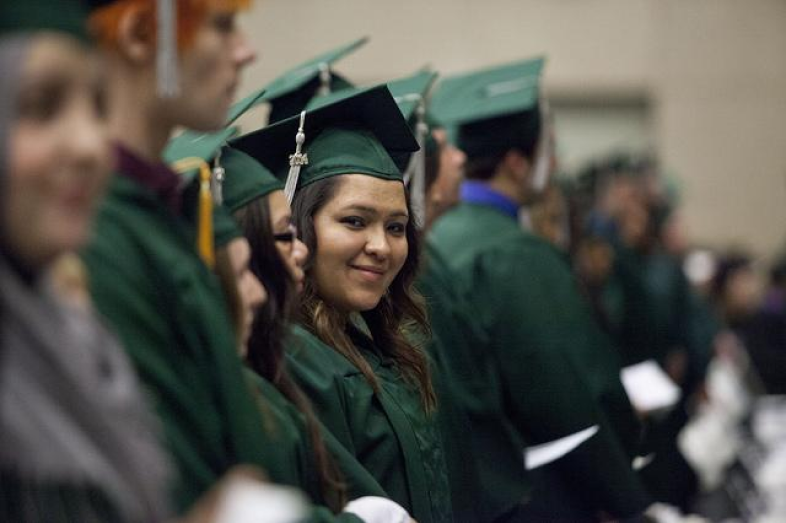

“A bad attitude is like a bad tire: You can’t go anywhere until you change it,” Arizona State University sophomore Ricardo Nieland told a roomful of journalists gathered on the campus for a seminar on innovation in higher education earlier this month.
Nieland was speaking on a panel about college students who are among the first generation of family members to pursue a degree. The session addressed the struggles many of these young adults encounter in higher education.
For Nieland, whose parents did not attend college, one such obstacle he faced was his family’s negative attitude toward higher education.
That was before Nieland’s mom discovered the ASU American Dream Academy, a program that offers eight- to 10-week courses that help parents who want to become more involved in their children’s education become familiar with the system and the tools their children need to be prepared for college. Since its launch in 2005, the program has reached nearly 350,000 parents and students, the large majority of whom are Spanish-speaking immigrants.
Nieland’s mom went through the program eight times, and he said the family’s perspective started to change as a result. His older sister was the first in their family to attend college and is currently working on her master’s degree while Nieland pursues a major in chemical engineering.
“We’ve traveled a long way because we got a good tire,” he said.
First-generation students like Nieland make up roughly one-third of all undergraduates. But many don’t have the support of a “good tire,” to borrow from Nieland’s analogy.
Aside from the lack of family and peer encouragement that many of these students experience, there are also systemic issues in education that negatively affect these students, said Maureen Hoyler, president of the Washington, D.C.-based Council for Opportunity in Education. Many first-generation students tend to select schools that are not among the most competitive academically and also have fewer resources to support students.
“We have a system of higher education that is stratified. We have a system of elementary and secondary education that is stratified. What we need is the pressure to make opportunity really available to people,” she said, voicing the need for more advocacy surrounding this topic.
College enrollment among students whose parents did not attend college has increased, but graduation rates are still an issue, Hoyler said. According to a 2011 UCLA study, 27 percent of first-generation students graduate with a bachelor’s degree in four years, compared to 42 percent of students whose parents went to college. That gap remains relatively unchanged when comparing five- and six-year graduation rates.
Among first-generation low-income students whose annual family income is $25,000 or less, four-year degree attainment rates are significantly lower, with only 11 percent earning a bachelor’s degree.
“If people don’t have people to turn to on the campus, if they don’t have people to fight for them on campus and to advocate for first-generation students, we’re not going to change” the graduation rates, Hoyler said.
The College Advising Corps hopes to provide those advocates for students — even before they step foot on campus. With a mission to “increase the number of first-gen, low-income, underrepresented students that apply to, enroll in, and graduate from college,” the nonprofit organization employs nearly 600 recent college graduates who serve two-year terms as advisors counseling high school students in 15 states across the country, said Regional Program Director Audree Hernandez. These corps members help high school students navigate through college searches, the application process and financial aid.
With such one-on-one academic advising, Hernandez, a first-generation college graduate herself, said it might not have taken her 13 years to complete her college degree.
With a similar goal to increase college enrollment and graduation rates as well as college readiness, specifically among Arizona’s Latino population, the American Dream Academy set out to train parents to become the students’ No. 1 advocates.
“Our desire was to help attack the issue from both ends,” said Alex Perilla, the program’s director. “We absolutely, positively need additional policies, additional support, additional investment from the top, but we thought that we should also make sure that students were graduating from high school and thought that families were really essential to that whole process.”
Perilla said one of the first questions they ask parents who enroll in the Academy is whether they feel they are their child’s main educator, and most of all of them agree. But when asked if they feel equipped to guide their child to a university, an overwhelming majority of the parents say no.
Lack of interest or low levels of education are not to blame, Perilla argues. Understanding and navigating the system can be complicated for anyone who is not an education professional.
Policies and procedures can change every year, or every day, Hoyler pointed out. “If you get the wrong advice, your Pell eligibility can be gone, so many things can be gone.”
For Nieland, the academic and emotional support he receives at ASU has motivated him to succeed, he said.
And if he has any questions, he can always call his mom.